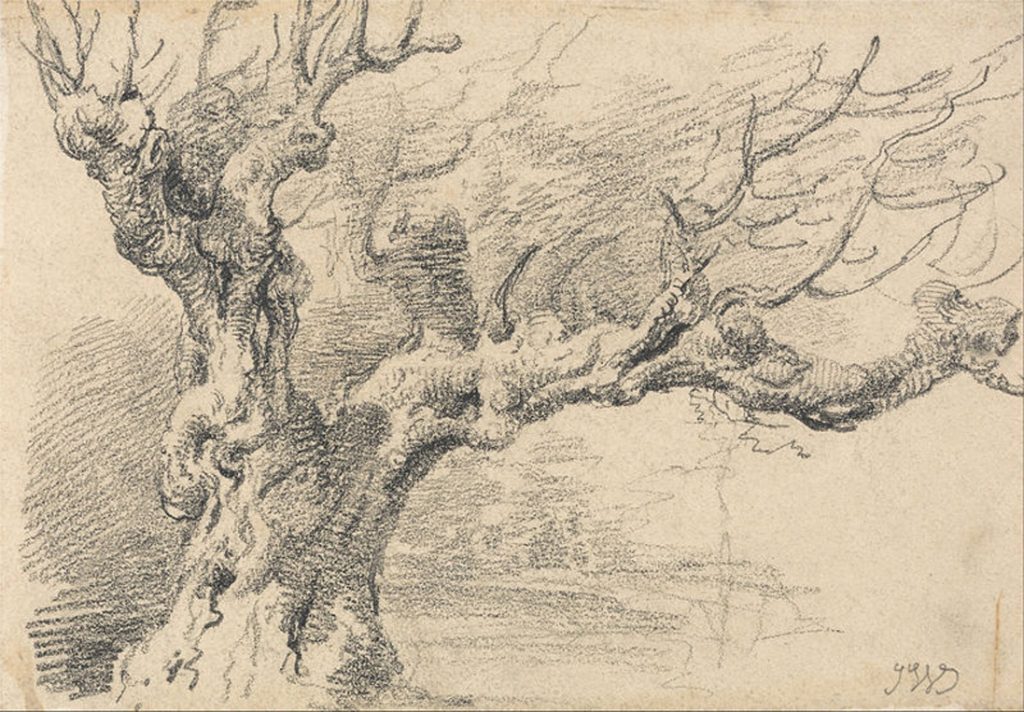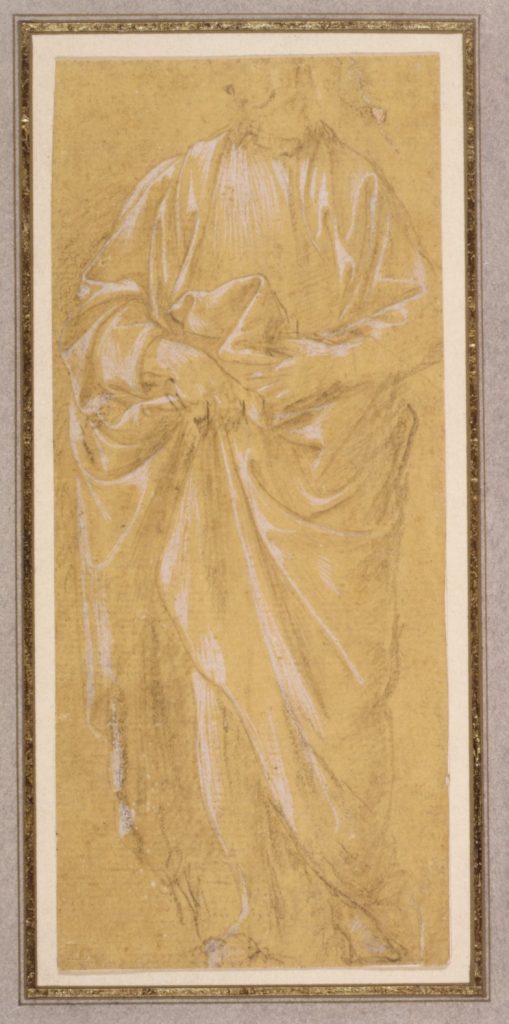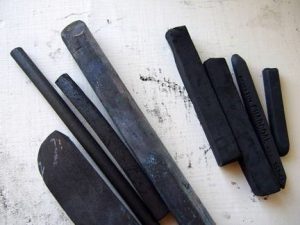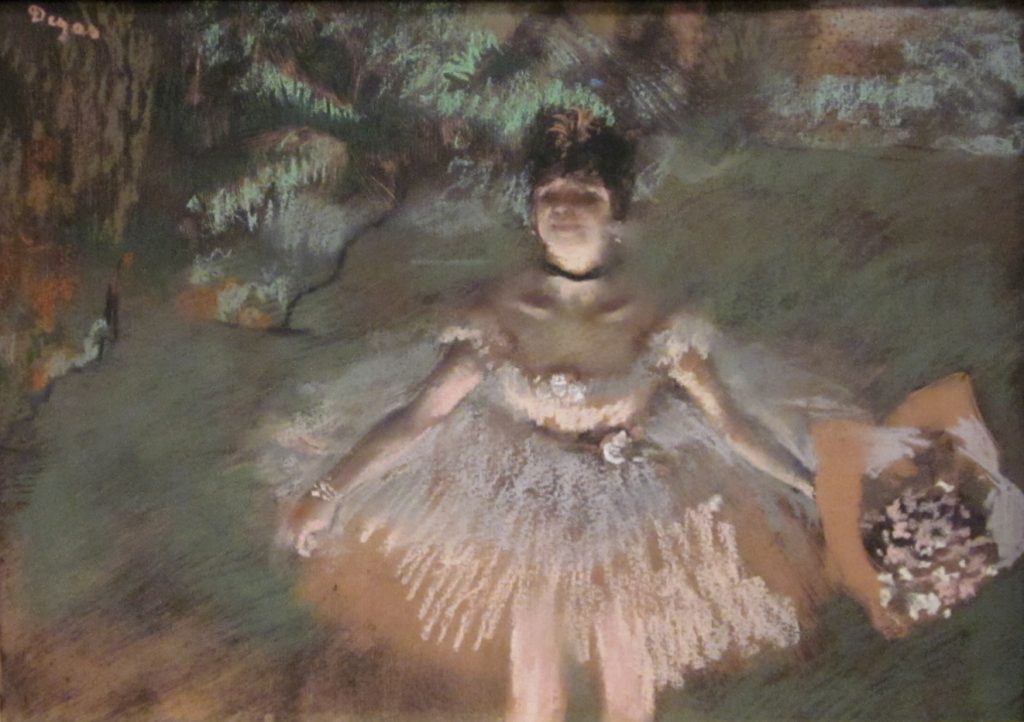4 Drawing
Learning Objectives
- Identify and distinguish various drawing media and techniques.
Drawing
For centuries charcoal, chalk, graphite and paper were adequate tools to launch some of the most profound images in art. Leonardo da Vinci’s The Virgin and Child with Saint Anne and Saint John the Baptist wraps all four figures together in what is essentially an extended family portrait. Da Vinci draws the figures in a spectacularly realistic style, one that emphasizes individual identities and surrounds the figures in a grand, unfinished landscape. He animates the scene with the Christ child pulling himself forward, trying to release himself from Mary’s grasp to get closer to a young John the Baptist on the right, who himself is turning toward the Christ child with a look of curious interest in his younger cousin.

The traditional role of drawing was to make sketches to plan the compositions that would finally be made manifest as paintings, sculpture or even architecture. Because of its relative immediacy, this function for drawing continues today. A preliminary sketch by the contemporary architect Frank Gehry captures the complex organic forms of the buildings he designs.

Types of Drawing Media
Dry media includes charcoal, graphite, chalks and pastels. Most of these drawing media are made by combining pigment (the color source from materials like ground charcoal or minerals) with a binder which allows it to be formed into a stick or suspended in a liquid (for wet media like ink), and that let it adhere to the surface of paper. Each of these mediums gives the artist a wide range of mark-making capabilities and effects, from thin lines to large areas of color and tone. The artist can manipulate a drawing to achieve desired effects in many ways, including exerting different pressures on the medium against the drawing’s surface, or by erasure, blotting or rubbing.
Artists use drawing in a number of ways. In art school, gesture drawing – quick, big movements that develop hand/eye coordination – is a standard. Artists often use similar quick drawings as preliminary sketches to capture the images they will further refine in a finished painting, sculpture or other work. Sometimes artists make finished drawings that are collectable pieces of art in their own right.
This process of drawing can instantly capture the sense of character in an image. From energetic to subtle, the immediate and unalloyed spirit of the artist’s idea are apparent in the simplest works. You can see this in the self-portraits of two German artists: Kathe Kollwitz and Ernst Ludwig Kirchner.

Kollwitz was a German artist of the twentieth century. She was the first woman to be elected to the Prussian Academy of Arts. Her work records the suffering of common people, especially mothers, after WWI and II. Kollwitz’ work in this self-portrait shows how expressive charcoal can be with an economy of means such as the quick gestures with which she has drawn her sleeve.
Wounded during the First World War, Kirchner’s ‘Self-Portrait Under the Influence of Morphine‘ from about 1916 presents us with a nightmarish vision of himself wrapped in the fog of opiate drugs. His hollow eyes and the graphic dysfunction of his marks attest to the power of his drawing.

Graphite media includes pencils, powder or compressed sticks. Each one creates a range of values – or range of tones from light to dark suggesting light and shadow – depending on the hardness or softness inherent in the material. Hard graphite tones range from light to dark gray, while softer graphite allows a range from light gray to nearly black. James Ward captures the texture of this old tree using line, hatching, cross-hatching and areas of smudged shadow.

Artists buy graphite pencils according to hardness – B suggests a level of softness which allows for very dark darks while HB or H usually indicates a very hard “lead” and a sharper, thinner, grayer line quality. Graphite is a naturally occurring form of carbon that was mined but now is extracted from various ores. Mixed with clay (the binder) and encased in a wooden tube it became the drawing medium we know today. As with the other dry media we will discuss, the higher the content of the binder the harder or less amount of pigment will be left behind on the support (paper or other material being drawn upon).
Metalpoint
Metalpoint was historically used in much the same way graphite or pencils are today. Some contemporary artists still work in metalpoint, but it is not common. During the Renaissance artists like Fra Fillippo Lippi made drawings using metalpoint on a prepared surface. The support, or drawing surface, must be covered with a ground – a preparation made in the Renaissance of bone ash, glue, and white pigment in water. Other pigments can be added to give the surface a pale color like pink or, as in this case, ochre (yellowish brown). The metal – usually a silver wire encased in wood like the graphite in a pencil – would be drawn over the dry surface of the support leaving traces of the metal behind. Silver tarnishes and darkens when exposed to the light, and it does on paper as well. The big issue was erasing – this could only be done by painting over the image with the ground and starting again.

Charcoal
Charcoal, perhaps the oldest form of drawing media, is made by simply charring wooden sticks or small branches, called vine charcoal, but is also available in a mechanically compressed form. Vine charcoal comes in three densities: soft, medium and hard, each one handling a little differently than the other. Soft charcoals give a more velvety feel to a drawing. The artist doesn’t have to apply as much pressure to the stick in order to get a solid mark. Hard vine charcoal offers more control but generally doesn’t give the darkest tones. Compressed charcoals give deeper blacks than vine charcoal, but are more difficult to manipulate once they are applied to paper.

Charcoal drawings can range in value from light grays to rich, velvety blacks. A charcoal drawing by American artist Georgia O’Keeffe is a good example.

Chalk
Artists can get a full range of color from chalk, pastel, and crayon. Chalk comes primarily from finely textured stone that can be combined with binders like clay. Red chalk like that Michelangelo used to create his study for the Libyan Sibyl on the Sistine Ceiling would have been made of iron oxide and clay. Artists often use a touch of white chalk or paint to create highlights in drawings in other mediums. Chalk is not as widely used today as it was in Michelangelo’s day, but can still be found. Other varieties of chalk are black, made of a composite of carbon and clay, and the traditional white chalk made of calcite or calcium carbonate.

https://www.metmuseum.org/exhibitions/listings/2017/michelangelo
See the above link for a discussion of this image by a curator at the MET.
Crayon
Crayon and Pastels are essentially made of pigment combined with a waxy or greasy binder and usually compressed into stick form for better handling. With these a full range of hues (colors) becomes possible. Crayons use a binder of wax and oil – artists’ crayons come in a wider range than childrens’ crayons and they are a little more dense, but the idea is the same. Because the binder is more substantial crayon is less easily blended than other media. A crayon with a creamier consistency that is blendable is called oil crayon or oil pastel. And the conté crayon, invented in 1795 by Nicolas-Jacques Conté, was created from a combination of clay and graphite in response to the shortage of graphite during the English blockade of France during the Napoleonic Wars.1 Conté crayons were relatively cheap to manufacture and could be made in various degrees of hardness. Today conté crayons come in a variety of colors besides black including red and gray.
Georges Seurat, the inventor of the pointillist technique, used conté crayon on paper with a very raised “tooth” – or surface texture – to approximate his dot technique in drawing. The waxy crayon sits on the elevated weave of the paper leaving the valleys white creating a kind of automatic dot screen.

Pastels
Pastels are like very soft chalk that come in a huge variety of colors. They are characterized by leaving soft, subtle changes in tone or color and give the effect of paint in many cases because of the possibility of blending. Pastel pigments allow for a resonant quality that is more difficult to obtain with graphite or charcoal. Picasso’s Portrait of the Artist’s Mother from 1896 emphasizes these qualities.

You can see where Picasso has blended the pastel in her skin areas especially. It looks very much like an oil painting, but if you look closely at the hair that brushes her neck in back you can get a sense of the soft, dry chalky pigment going down on the paper surface. Paper used with pastels usually has more tooth, sometimes resembling velveteen with tiny hairs that allow the dry pigment to sit between them. Modern pastels are usually fixed with something like a spray-on acrylic to hold the pigment in place.

Degas used pastels to create soft, painterly images, especially of dancers. The Phillips Collection has an informative short essay on his process here: http://blog.phillipscollection.org/2011/12/20/degas-and-pastels-part-i/

More recent developments in dry media are oil pastels, pigment mixed with an organic oil binder that deliver a heavier mark and lend themselves to more graphic and vibrant results. The drawings of Beverly Buchanan reflect this. Buchanan was an African-American artist whose work celebrates rural life of the south centered in the forms of old houses and shacks. The buildings stir memories and provide a sense of place, and are usually surrounded by people, flowers and bright landscapes. She also creates sculptures of the shacks, giving them an identity beyond their physical presence.

Drawings are also done in wet media. It is the linear quality of the work that determines its genre (drawing) even though the media is more like paint than pencil.
Wet Drawing Media
Pen and Ink
Drawings are also often done with a pen and ink. The ink again uses pigment, both colored and black, but suspended in a liquid medium. Sometimes gum arabic – the hardened sap of the acacia tree – is added to help with adhesion and viscosity. Many different cultures and throughout different periods in history pen and ink drawings have served to capture quick impressions of a scene or put down an artists initial ideas about a larger and more complex work. Some ink drawings are finished compositions in their own right.
Pen nibs are the point of the pen; metal pen nibs like those used today have been around for a relatively short time – only since the 19th century. Earlier versions of pens used things like reeds with one end sharpened to a point, or a bird’s quill similarly sharpened. More technical drawings are made today by a tool known as a rapidograph pen. Here the metal points allow ink to flow through them onto the paper. They come in a variety of thicknesses allowing for lines of varying widths.
Brush and Ink
Soft pointed brushes are also used to make drawings with ink. The artist’s dexterity with the brush allows for the variety in width of line. Drawings made with brush and ink is a tradition in the East in particular.

Paper and Erasers
Paper itself can be used to make drawings – or at least very linear images. Erasers also function in the drawing process for many artists. One artist, Robert Rauschenberg, made an entire “painting” or “drawing” with an eraser. We will see him explain it himself in a video in class.
Papermaking has been around for literally hundreds of years. Historically it is traced back to 105 CE when Cai Lun, an official with the Han Dynasty in China, made paper with natural fibers and old fishing nets. From China it spread by way of the Silk Road to the Islamic world, and by way of the Crusaders, most likely, to the West.
Not surprisingly, the Kingdoms of Northern Spain in the 12th century were the first European areas to develop papermaking of their own, probably because of the Islamic heritage in that country. In Italy by the 13th century paper was made using rags, a rigid wire mold and gelatin sizing.2
Today papermaking is practiced by artists as a discrete artform. Necessary is some method of pulping organic rag material which is then poured onto the wire mesh frame molds and stacked to dry. The molds are called “deckles” and the word is then used to describe the uneven end that is characteristic of hand-made paper.

Commercial papers are sold today by weight. 500 sheets of paper are called a ream; 500 sheets of a good, heavyweight paperstock weighs more than 500 sheets of a cheaper copy paper stock and costs accordingly. Good paper for wedding invitations and the like might be made on 100 lb. stock while copy paper is about 60 lb. or less.
Good quality paper is thick and holds up well to various wet media. It can also be used to create paper sculpture, a popular illustrative medium. Here are a few examples of the kind of work being done with – as opposed to on – paper.
Collage
Paper itself can become a drawing medium. Picasso and Matisse pioneered the “papier collé”, or collage, in the early 20th century. In the middle of the 20th century artists like Romare Bearden, an early member of the Harlem Renaissance, used cut and pasted papers in a particularly expressive way to record the experience of African-American culture.

Paper Sculpture
Paper itself can be the drawing medium. Paper, manipulated, glued, and sometimes painted has been a popular medium for illustration and gallery art. In this example, individual pieces of a heavy hand-made paper that could withstand soaking in water were cut out, bent and shaped, then pasted down on a black surface to create a Surrealist-inspired image for an album cover for a string quartet.

Licenses and Attribution
© Saylor Academy 2010-2017 except as otherwise noted. Excluding course final exams, content authored by Saylor Academy is available under a Creative Commons Attribution 3.0 Unported license. Third-party materials are the copyright of their respective owners and shared under various licenses. See detailed licensing information.
Saylor Academy and Saylor.org® are trade names of the Constitution Foundation, a 501(c)(3) organization through which our educational activities are conducted.
Artist’s Official Website: http://www.beverlybuchanan.com/
Contributions to http://artworldsofatlanta.wikispaces.com/ are licensed under a Creative Commons Attribution Share-Alike 2.5 License. 

